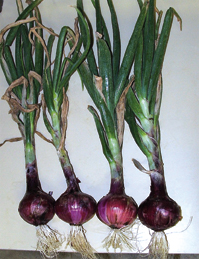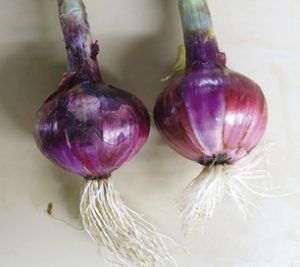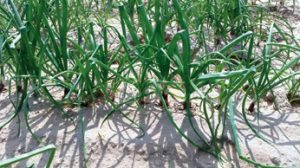By Larry Zibilske, Vice President of Research, TPS Lab
In onion production, the recommended amounts of the common fertilizer nutrients nitrogen, phosphorus and potassium vary greatly depending on the cultivar, location and, sometimes, soil type. A common theme in these recommendations is to add the nutrients needed, based on soil test results and local factors, in a few “split applications.”
An important rationale for splitting fertility applications is to ensure adequate amounts of nutrients are present later in the season as bulbs fill rapidly. This approach recognizes that loss of nutrient availability in soil is high when nutrients are applied at planting. Chemical and biological transformation of the nutrients, making them less available to plants, is more likely the longer the raw nutrients are present in the soil. Splitting fertilizer applications reduces these losses but cannot totally prevent them.
Nutrition and Yield
Splitting fertilizer applications increases uptake efficiency, which can increase profits. The question is do we get even more benefits from increasing the number of splits? In theory, yes. Why? Because splitting fertilizer applications more resembles the way in which plants grew in soil before cultivated agriculture came along. Plants feed every day, so they do best when they have access to adequate amounts of nutrients every day. In earlier times, these nutrients came from the decomposition of organic matter. Microbes break down organic matter and release nutrients a little at a time over the whole season. In response, plants developed powerful abilities to efficiently take up the smaller amounts of nutrients.
But we don’t really want to grow onions with minimal fertilization. Yields would suffer. So how can we take advantage of split applications and still produce good onion yields? There are two concepts that will ensure good (probably better) yields with split applications.
The first concept is timing. Plants need different amounts of fertilizer nutrients at different times during the season. For instance, phosphorus is needed in moderate amounts early in the season. If all or most is applied pre-plant, it is exposed to chemical changes that later restrict uptake into the crop. Later on, the crop may run out of phosphorus because that added at the beginning is no longer available and the plants suffer deficiencies.
Another example is nitrogen. Nitrogen is usually the largest need. Early plant growth actually needs little nitrogen. If added in large amounts early, crops suffer from large necks and leaves, reflecting luxuriant growth that is more susceptible to diseases and insects. Most of the nitrogen is needed later in the season. Increasing nitrogen application in a later split promotes healthier plants and greater yields.
Other nutrients follow this general trend of use, and it pays to make sure your fertilizer applications are done at the right time to get the most benefit. Application by drip or sprinkler irrigation greatly facilitates splitting applications, essentially allowing a “spoon feeding” management approach to fertilization.
The second concept is “balanced nutrition.” Onion, like other crops, needs different total amounts of the individual fertilizer nutrients. As mentioned, nitrogen is needed in the largest amount, but little nitrogen is needed early in the season. By splitting applications, nutrients can be individually adjusted to meet the needs of the crop at that time, providing lower amounts of nitrogen at the beginning, then increased amounts later.
Balancing these “macro” nutrients with the other required nutrients is important. Calcium, magnesium, sulfur and sodium are needed in addition to nitrogen, phosphorus and potassium. These minor elements are just as important and need to be included in fertilizer decisions. Micro- or trace nutrients, such as iron, zinc, manganese and copper, are also very important. They are needed in very small amounts, but they have a big impact on yield and quality.
It’s clear that fertilization of any modern crop is a complex task – more so now than in the past. It is important that the information you need to make these decisions is reliable and based on complete understanding of the newer crop varieties, including knowledge of all required nutrients. Ask your testing lab if it uses modern plant standards and basic crop physiology when making fertility recommendations.

Large necks indicate excessive early nitrogen applications.
Nutrition and Quality
Good yields and high quality are goals sometimes considered to be at odds. The thinking is that one compromises the other; great yields often come with lower quality. This does not have to be the case.
Following a “spoon feeding” program of basic fertility will go a long way towards achieving good yields, as well as high quality. But to really get the high quality, we must maintain adequate levels of micronutrients, such as boron, iron, manganese, zinc and copper. Of these, boron is often the most neglected and the most problematic in maintaining adequate levels for plant uptake. Boron is extremely important in all stages of growth. It is one of the “gatekeeper” elements that help direct other nutrients to where they’re needed in the plant. Coupled with the fear of boron toxicity, many instances of boron deficiency are found. Good, complete recommendations take all this into account to ensure the crop has enough boron to push yields and to maintain plants in a healthy condition. The other micronutrients are necessary for proper plant enzyme activity. These are needed to produce leaves and bulbs so are needed throughout the season.
High quality depends on the maintenance of sufficient amounts of micronutrients. During the season, addition of these when needed can be accomplished via irrigation or foliar sprays with a proper wetting agent. To determine whether nutrients are needed during the season, leaf samples need to be taken frequently for analysis. If these are taken on a 10-day to two-week interval, the results can be returned to you in plenty of time to address crop needs. This is the heart of the “spoon feeding” concept and is a superior way to keep the correct amount of nutrients available when the plants need them.
High quality also includes post-harvest issues. Firmness, shape, defects including harvest and storage damage, dryness of outer leaves and stems can affect quality. Most of these can be managed with proper nutrition and with special attention to certain nutrients. Calcium, magnesium, silicon and iron play a major role in minimizing susceptibility to damage and storage problems. Recommendations from your testing lab should include these.

Following plant analysis as a nutritional guide results in desirable, narrow necks.
Pungency
Pungency is one of the taste characteristics important to consumers. It is caused by a volatile oil that is produced in highest amounts when excessive sulfur in taken up by the growing onion. Varietal differences and market goals come into play here. While many consumers choose low-pungency onions, pungent varieties are often preferred for cooking. The point is that pungency is a quality index that can be managed for the desired goal.
Adequate amounts of sulfur are necessary for healthy onion growth. However, keeping sulfur at just that level is important to keep pungency low. Keeping sulfur acceptably low also affects sugar content. Higher sugar content also depends on maintaining low sulfur in the growing medium. Pyruvate assays for pungency are often 2.5 times lower in onions from lower sulfur growing environments, where sugar content is higher in the same conditions. Other factors, such as climatic conditions and storage issues affect pungency.
Soil characteristics can also affect pungency. Some soils, especially low pH soils, can contain much soluble sulfur. The plant available form of sulfur is the anionic form, sulfate. It is very water soluble and can be leached from the soil fairly easily. This process can reduce the amount of sulfur available to the plant which would reduce pungency. Other soils, notably high pH, gypsic soils, are very high in sulfur, but it is tied up in chemical forms. The pungency issue arises when these soils are treated with acid to reduce the pH. Using sulfuric acid to reduce soil pH is common, but obviously not recommended for future sweet onion production. But use of other acids will release the sulfur in large amounts from natural sources and cause pungency issues.
The other issue is high organic matter soils. These contain much organic sulfur, some of which is released by microbial action during the year that can result in too much taken up into the crop, leading to pungency issues.
Pungency is difficult to control via soil management, and the best hope lies with sulfur availability control with fertilizer management. Frequent testing for leaf sulfur content can provide the guidance growers need to control pungency to the extent possible.
Nutrition and Pests
In many regions, the major insect pests that affect onions are thrips and onion maggot. There is a role for nutrition in fighting these. Onions grown with a balanced nutrition plan are more generally resistant to insects. Building on that, the grower can boost silicon in the plant with foliar sprays. Silicon-treated plants show increased resistance to thrips and other insects. Improved plant silicon toughens the tissues and increases resistance to piercing.
In cooler climates, the major pest is often the onion maggot. Foliar sprays may not get much silicon to the roots to protect them from maggot larval invasion. More research is needed, but it is likely that a season-long silicon nutrition program, coupled with better health of plants grown with balanced nutrition, will help control onion maggot losses.
It should be noted that when silicon is recommended, we’re really talking about products that contain silicate, not actual elemental silicon. It would be difficult to accept that increasing silicon would have any effect at all because the Earth’s crust contains so much silicon to start with. Silicon is sparingly soluble in water; only a very tiny amount goes into solution naturally. Silicate is the soluble form that plants can take up and is the form contained in several products.

This field of drip-irrigated red onions is on a
split-application nutritional program.
Nutrition and Diseases
Onion diseases can wipe out a crop quickly. Downy mildew, white rot, pink root and purple blotch can result in significant losses. Prevention is a key, but there are good products available that will stave off disasters.
As well, a properly fed plant resists diseases generally. Several nutrients have been used to specifically retard disease progress in crops. Calcium, magnesium, silicon, sodium and potassium can provide a strong first-line defense against diseases. As these are part of the balanced nutrition plan, a double benefit is realized from improving plant content of these nutrients. This effective approach is used by watermelon growers. Sodium or potassium silicate foliar sprays are effective against mildews and insects at the same time. Using the baseline balanced nutrition program, the silicate sprays add to the control factors already in the crop.
Other Factors
There are other management factors that affect yield and quality in onion production. Building the soil establishes a “buffer” for nutrition and crop health. Rotating onions with dissimilar crops such as grasses breaks disease and insect cycles and improves the soil. Ensuring good air drainage from fields promotes drying which helps stem disease spread. Green manuring and other soil organic matter improvement plans provide a better biological environment for plant roots. Improved soil environments tend to make up for problems created by intervening in plant growth cycles to achieve needed yields and quality.
All these concepts translate to a more intense involvement in crop production. To achieve the best results, growers should start with a good soil test and start a program of leaf analysis during the season. Addition of nutrients based on the results of leaf testing allows growers to keep up with the changing demands of a growing crop. The return for this increased attention is better yields and quality. The expense of testing is greatly offset by the greater profit margins at the end of the year.
See more at TPS Lab
